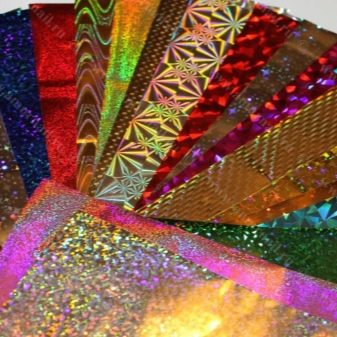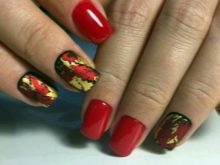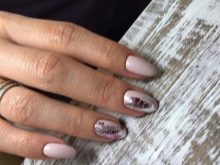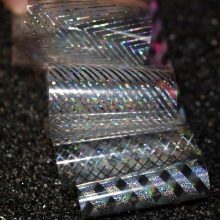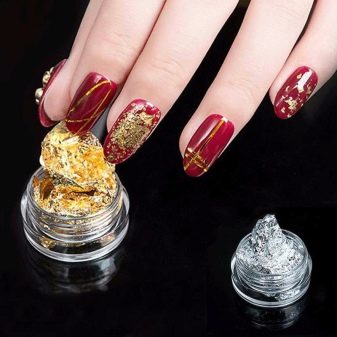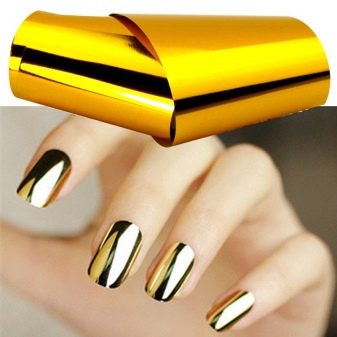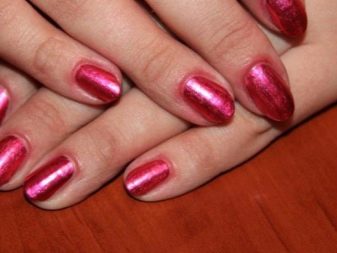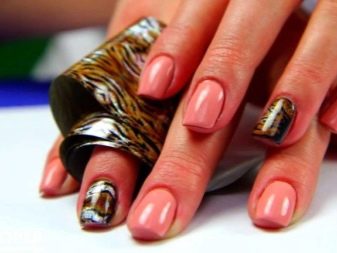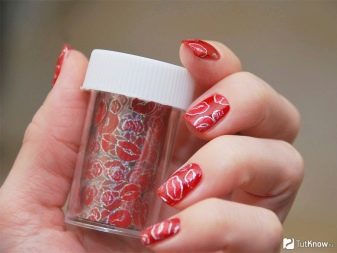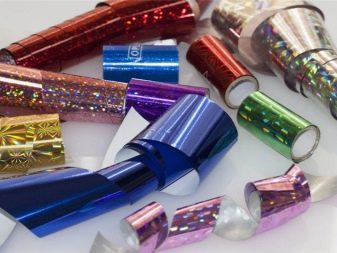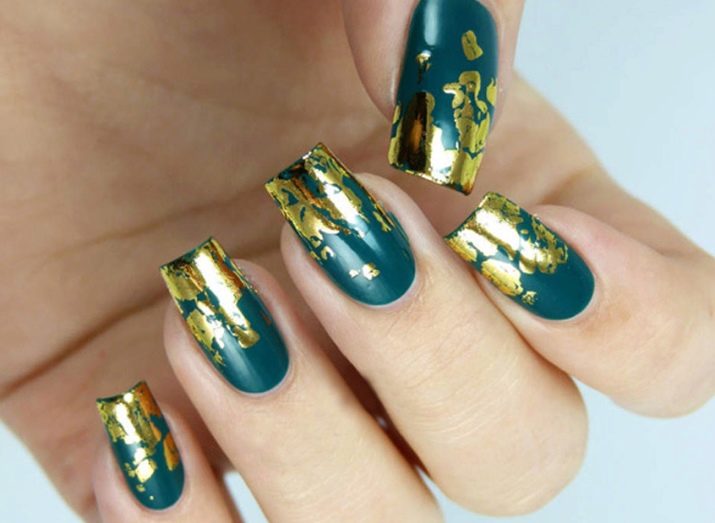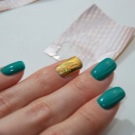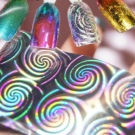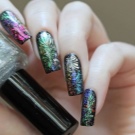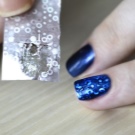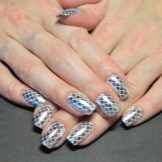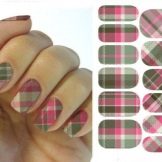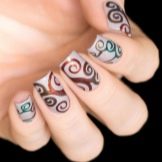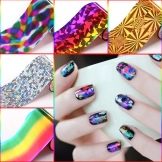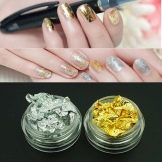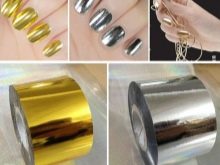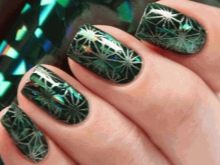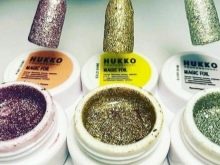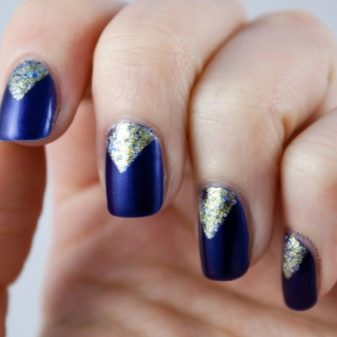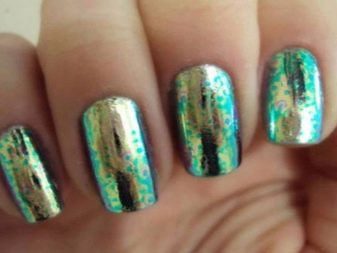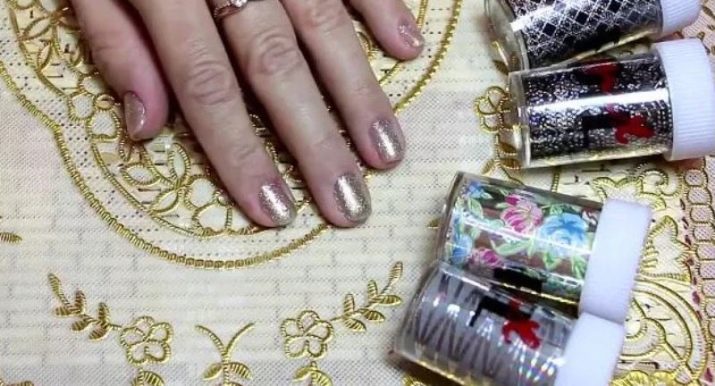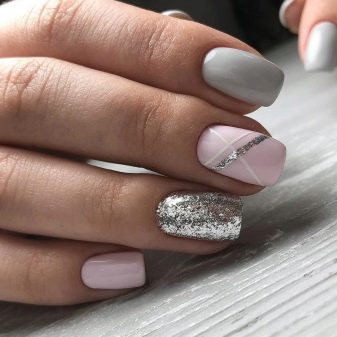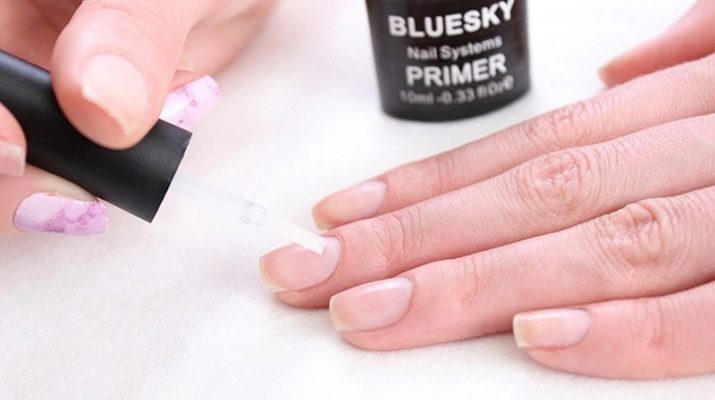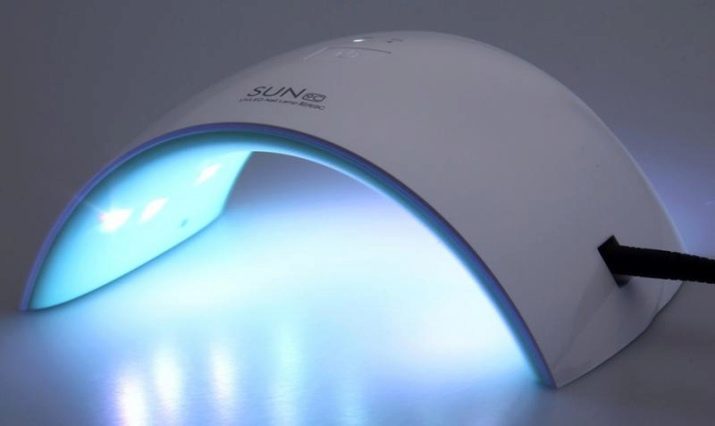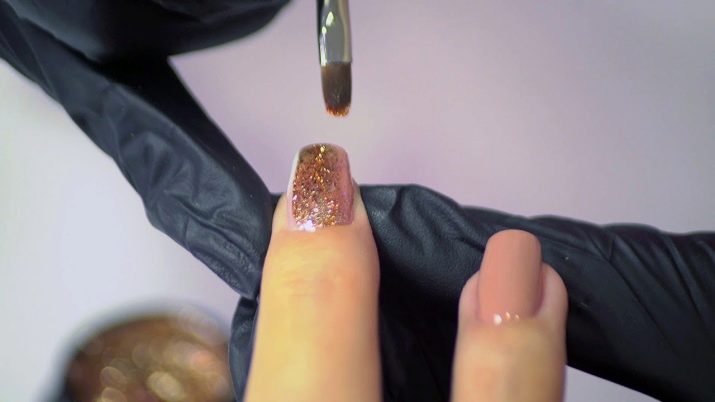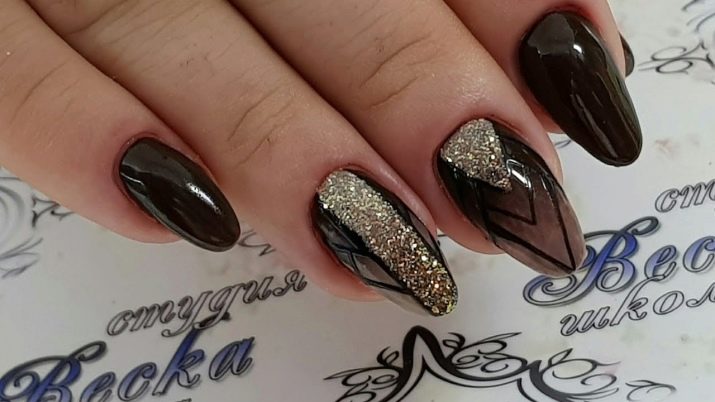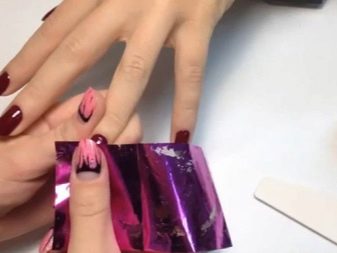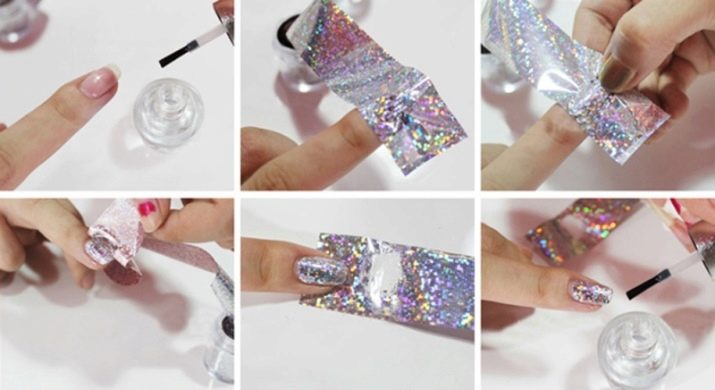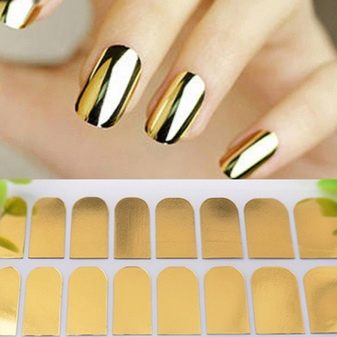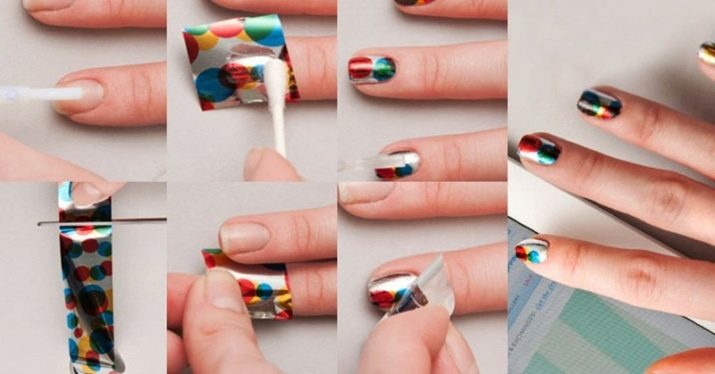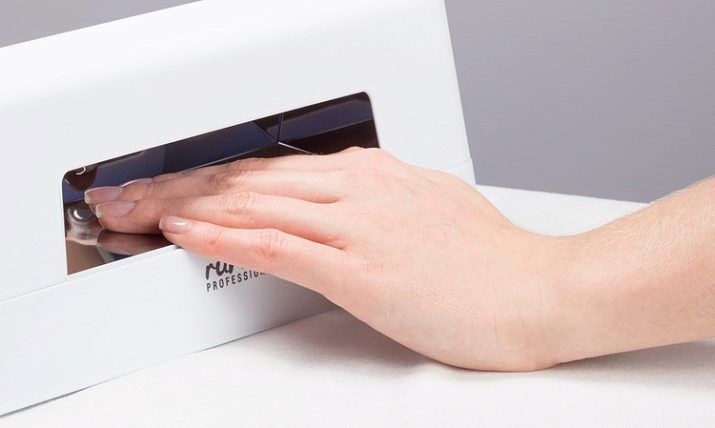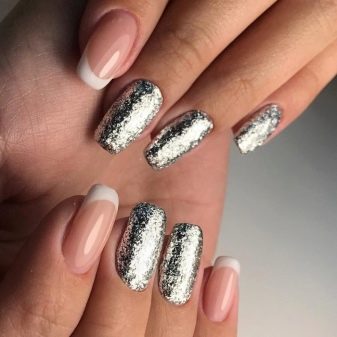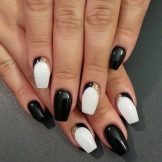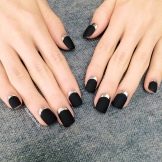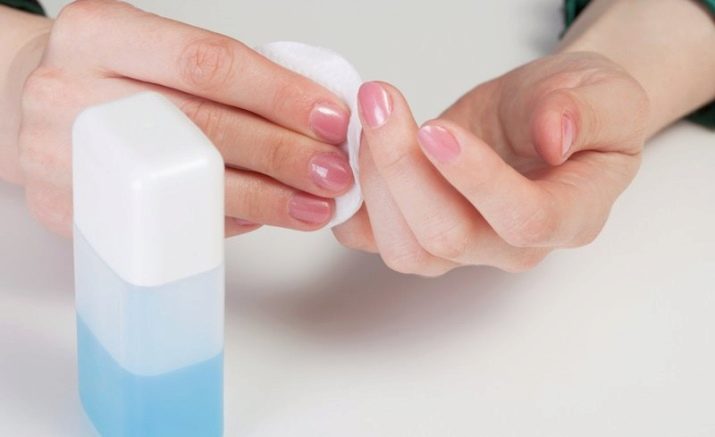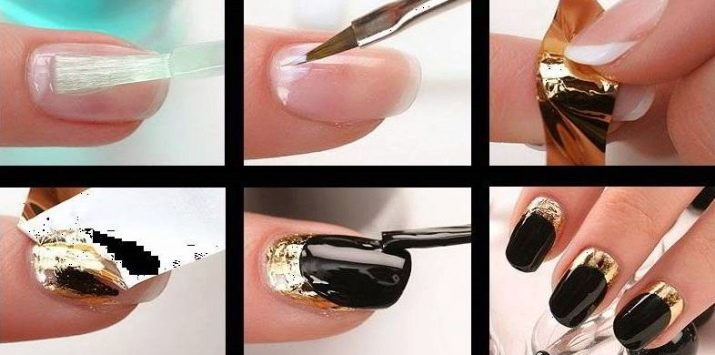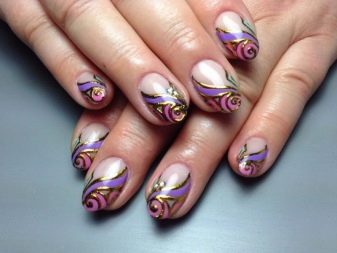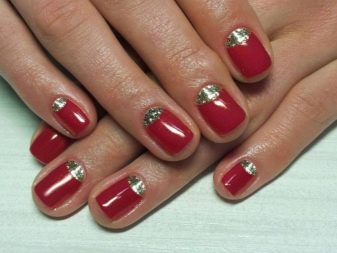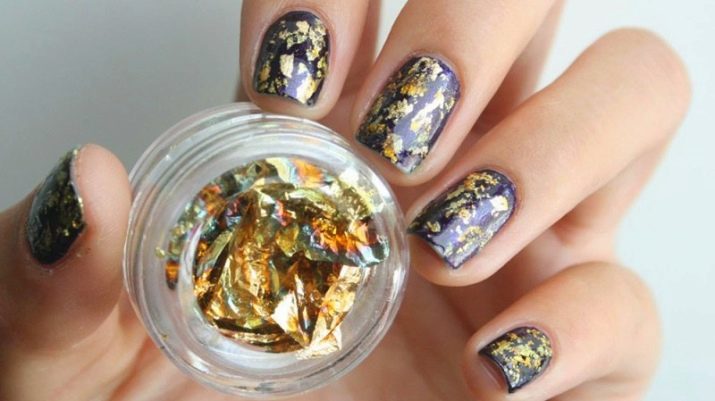Gel polish foil: what it is, types and application in design
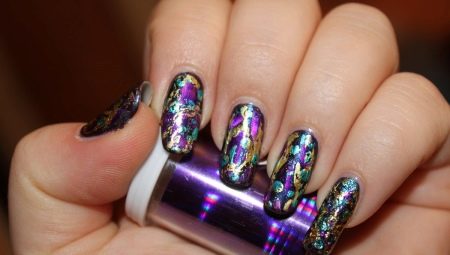
After the appearance of such material as gel polish in the manicure world, the masters began to invent various designs based on it. Foil has recently become one of the most popular decors. She greatly facilitated the work of novice masters and expanded the horizons of opportunities for experienced professionals.
What it is
What is it - nail foil?
In fact, this material is different from the usual food variety. It is sold in specialized outlets or through online stores.
In terms of affordability, it is not very expensive. However, for creativity, the material is very convenient, because it has plasticity, a wide color range and several ways of application.
With the help of foil, you can diversify the manicure, especially the design that is superimposed on the gel polish. In addition, you can work with her at home.
Thus, the foil makes the work of creating a unique manicure simple, interesting and allows you to create a design not only for special occasions, but also as a daily business option.
Advantages and disadvantages
Using foil to create a manicure has its pros and cons.
Among the advantages are the following factors:
- ease of application;
- ease of creating design;
- affordability;
- wide color range;
- huge range;
- the variety of possibilities allows you to create unique non-repeating images.
The disadvantages include such criteria.
- You can not wear a manicure with the use of foil. After 2 weeks of socks, nails rest is necessary, and it is desirable to carry out the procedure to strengthen.
- Design using glue less durable.
- Reproduction of a decor from a usual, not translated foil demands time for perfection: complications of patterns, accuracy of drawing.
- Self-design requires artistic flair, otherwise you will have to use images created by other artists or artists.
What are the types
Foil material for gel polish is produced in several types.
According to the method of application, there are three main types.
- Detachable. The material is produced and sold in the form of rolls or in the form of ordinary smooth sheets of small format. Decorative elements are cut or torn off by special perforated lines, they are applied to the nail plate with tweezers and fixed with special means. If any blemishes form during work, they can be easily removed with a nail file.
This type of material requires accuracy, precision and skill.
- Translated. Foil is also available in rolls, which are packed in plastic containers, which increases the reliability of storage. Due to its characteristics, this material is suitable for beginners, as well as for creating a manicure with your own hands. Manufacturers offer a wide range, there are many colors, textures are different. In addition, some species have decals or patterns. Due to a certain method of applying, the foil got its name: the material is applied to the nail, treated with glue, smoothed, and then the substrate is torn off, leaving a decorative layer on the nail plate.
- Thermofolg - This is not an ordinary foil, it is a special kind of film that needs to be heated before applying to the nail. Heating will make it supple and obedient. All surplus are removed with a nail file.
The form can be classified foil into the following types.
- Leafy usually does not have a sticky layer, so you need a special glue to use it. It is perfectly suitable for cutting various decorative parts, as there are different shades and textures.
- Tattered similar to gold leaf, very thin. Manufacturers produce it in small jars in compressed form. It can be spread on a slightly dried gel polish without glue, but only using tweezers. When applying should be careful, because it is easily torn, but allows you to create an unimaginable number of unique designs.
- Scotch - A special decorative version of the foil in the form of narrow strips with a sticky seamy layer. It can be colored, manufacturers offer a wide variety of shades. Masters use it not only as decoration, but also as stencils when depicting geometric patterns.
- Stickers - The easiest version of the transfer foil. In this case, the picture has already been completely created by artists, it remains only to remove the substrate and gently attach the picture with a sticky layer on the nail surface.
The texture of the foil is also different.
- Smooth
- Embossed. This type becomes more diverse, new patterns and colors appear. Since a foil embossed pattern is applied to the foil, it is thicker than its fellows. The material is sold either in rolls or in the form of sheets. Sometimes the embossed material is used as a stencil for applying sketches with gel varnish.
- Liquid. In the role of this material is gel polish with the addition of small glitter. It provides complete creative freedom, eliminating the complexity of the work of cutting out the necessary details, you can simply draw them.
Application Methods
In any kind of art before you start to create, you must carefully prepare. So here: before proceeding to the design of the manicure on gel polish with foil, you should process your nails according to the basic technology.
- Remove old decorative coating.
- Remove cuticle. For this purpose, they use either the classical method or special means for its removal.
- Trim nails to desired length.
- Give the nails the desired shape using an abrasive nail file.
- Polish nail plates with a buff to give smoothness and shine. This type of nail file is very suitable for nail art, because the gel lies more evenly on polished, even nails and lasts longer.
- Degreasing.
- Applying a base coat of varnish and drying it under a UV lamp.
- Tinting gel varnish background color.
- Drying
Only after the implementation of all these actions, you can proceed to the decoration of a manicure.
There are several techniques and technologies for the distribution of foil on gel varnish. Consider the most popular. They can be used as a guide for getting a manicure at home.
Uniform foil coating of the entire nail plate
In this case it is possible to apply both detachable and transferable material.
After making a basic manicure, proceed to the design with the use of foil.
Variant with glue
After the gel polish of the main shade has been applied and dried on the nails, the dispersion layer is removed from them with special napkins.
In the case of the use of tear-off foil, you need to worry in advance and prepare the parts, cut them to fit the nail. For translation type, these actions are not needed.
Next, follow the glue treatment. It is better to use a tool with a manifesting effect, which will greatly facilitate the work and allow you to properly evaluate the time of its drying.
As soon as the adhesive becomes transparent, you can attach the foil to it.
An important condition is that the material should be laid and smoothed with a pusher or a cotton swab, tightly pressed to the plate.
After careful stroking, the substrate of the transfer foil is removed. Excess foil on the edge can be removed with a nail file.
After all these manipulations, the nails are covered with a transparent finishing top. Further, it is dried under a UV lamp for at least three minutes.
If all actions are carried out correctly, you get an even and beautiful manicure, on which you can additionally apply patterns. Do not forget that then you need to once again fix everything with a finishing top.
After the final drying, the nails are treated with a dispersion and a special oil is applied to the cuticle.
Option without glue
When working with foil, adhesive means can be not used, but can be transferred directly to gel polish.
After applying the first gel layer and drying it is not necessary to remove the sticky (dispersion) layer, it will serve as an adhesive base. Further, the foiled parts are applied, smoothed by the available tools.
After 10-15 seconds, the substrate of the translated "gold" is removed. Top finish fixer is applied on top and dried under the lamp. Defects are eliminated with a nail file. Lint-free napkins remove sticky plaque.
Manicure with liquid foil
Gel Polish "liquid foil" appeared relatively recently. It is a gel mixture with fine glitter. Apply a tool easy, and the effect is obtained, as when using this foil.
Application technology consists of several standard stages.
- Basic nail processing is to give them the desired length and shape. The cuticle is also removed and the plates are polished with a buff.
- Cleaning of nails from abrasive dust after polishing and their degreasing with klinder
- Primer manicure is a special tool called primer. Firstly, it qualitatively degreases the surface, secondly, it provides good adhesion of gel polish to the nail. Thanks to the primer, the peeling of the gel does not occur, the durability of the manicure increases. In addition, it protects the nail plate from the chemical elements that make up the gel varnish from the penetration of bacteria and fungi.
- Drying a couple of minutes on ordinary air.
- Basecoat application.
- Drying: using an ultraviolet lamp - 2 minutes, under the LED device - half a minute.
- Coating with liquid foil. Before starting work, the bottle should be gently rolled between the palms so that settled glitter mixed. Important: the lacquer cannot be shaken, otherwise bubbles form, and they do not allow to get a smooth coating.
When applying the gel to the brush is not necessary to press.
- Polymerization under the lamp: UV - from 2 to 3 minutes, LED - from 0.5 to 1 minute.
- For a more saturated effect, you can impose a couple more additional layers, subjecting the manicure to polymerization after applying each.
- Topcoat. The manicure is sealed with a colorless top on all sides; the cut of the nail and the ends should be especially carefully processed.
- Another polymerization procedure with a fixed time interval.
- Removal of the dispersion layer with a klinsser.
- Additional decoration. At this stage you need to connect the fantasy. Application of a list, various stickers and other decorative elements is welcomed.
- Final top coating, its drying and processing with klinser.
The range of brilliant gel polish is still not as wide as we would like, but the choice is still quite large. You can choose an option with a good price-quality ratio.
Use pattern
For novice masters invented many facilitating the work of details. These include templates and stencils.
These auxiliary tools are made of sufficiently strong, non-oxidizing materials. Manufacturers today offer a wide range of sketches.
In order to convert the foil to gel polish, you need to follow the following algorithm.
- Wait until the main coating is completely dry.
- Template to impose on the nail plate. Some stencils have an adhesive inside that allows you not to worry about his unexpected movements. If there is no such layer, then you will have to monitor the immobility of the template yourself so that the drawing does not smear.
- Next, glue is applied over the template.
- Only after the adhesive has dried to the desired degree should foil be applied. It is necessary to press it properly and hold it for a few seconds.
- The next step is to remove the template along with the foil.
- As a result, the nail will remain a beautiful pattern, which was obtained without any effort.
Patterns are also used when working with liquids. In this case, the liquid foil is applied with a brush to the background coating through a stencil.
Even professional craftsmen are happy to use such improvised tools to create complex designs using monograms and elaborate patterns.
Thermofoil application
Thermofolg is the simplest way to get an interesting manicure without much effort.
After basic preparation of the marigold and removing the sticky layer, it should be treated with a buff to improve the adhesion of the film to the nail surface.
Blanks should be cut in advance in the shape of the nail.
For work you will need a hair dryer or a lamp. The foil is heated by warm air, it becomes more plastic and pliable, which is necessary for its uniform distribution.
In order to avoid the appearance of bumps and other irregularities, thermofoil is smoothed with a special wooden stick or pusher.
After the material is “grabbed”, excess film is removed with nail scissors, smaller defects are removed with a nail file.
A colorless top fixer is applied over the foil and dried under the lamp. Professionals recommend applying it twice.
In the final, the sticky layer is removed with the help of a klinser. That's all, manicure with thermofoil ready.
French and moon manicure
Classic manicure with foiled elements looks neat and stylish.
To play it does not require much experience and skill. It is suitable for nails of any length and shape.
Classic design is perfect for beginners starting to work with gel polish.
1 option
At the initial preparatory stage, the main shade is selected, details from the foil are cut out in the shape of a well for a moon or an edge for a service jacket.
Metallic colors go well with black, gray and white colors, as well as with monochrome companion shades.
At the second stage, the standard treatment is carried out, a basic manicure is applied.
Next, apply the gel polish of the selected shade and dry under the lamp.
The nail surface is treated with klinsser.
The edge or hole, depending on the chosen type of manicure, is covered with an adhesive. It is necessary to wait for it to dry up to the desired condition, after which the folded parts are carefully laid out with tweezers and pressed with a special nail stick.
This is followed by a transparent layer of gel-fixer, drying it under a UV lamp and removing the dispersion layer with lint-free wipes.
Option 2
If in the first case, color gel-lacquer was first applied, and then foil, in the second case - vice versa.
On the base coat, the metallized material is first laid out. And here it is not necessary to strictly adhere to the form. The main thing is to be completely closed hole or, respectively, the edge of the nail.
Foil is better to impose directly on the gel Polish, without removing the sticky layer. Translation material will greatly facilitate the work. It is important to remember that the foil parts need to be carefully smoothed while simultaneously pressing against the surface.
Further, there is a transparent fixer, drying and processing with a klinsser.
After that, proceed to applying a contrast gel polish, leaving not filled areas of the hole or edge.
The layer is fixed again with the top and dried well under the lamp.
After removing the dispersion layer, the manicure is ready.
The classic design with the use of foil on gel varnish looks spectacular. You can choose the color scheme in such a way that the manicure is not a business, but a solemn option.
Lifetime manicure with foil
The durability of the foil depends on its quality, the correctness of action and accuracy in creating a manicure.
You can not break the technology. It is necessary to consistently perform all actions, thoroughly dry each layer of gel polish.
Properly applied manicure with foil will last for about two weeks, whereas using ordinary lacquer only a few days.
Beautiful examples
Professional masters and beginners are equally happy to use foil to create unique designs on gel polish. Images turn out bright and effective, business and solemn, podium and natural. And you can get them without much effort, quickly, easily and simply.
Popular classic jacket with foil looks more festive.
Lunar manicure on the gel polish can be created using both conventional foil and liquid.
Mirror or metallic luster can be obtained by applying monophonic foil. It turns out effectively and boldly.
Liquid foil allows you to create interesting designs. It is not necessary to cover all the legs with this brilliant gel at once; it is enough to select at least one or two to make the manicure play in a special way.
Using compressed foil, you can get unimaginable design images that will never be repeated. And the smaller the pieces, the more natural the decor looks.
With the help of foil, gel lacquer can depict any decor: futuristic, vegetable, snow, star, “broken glass”, casting, craquelure and many others. It all depends on the imagination and imagination of the master.
How to make a manicure with foil, see the following video.

